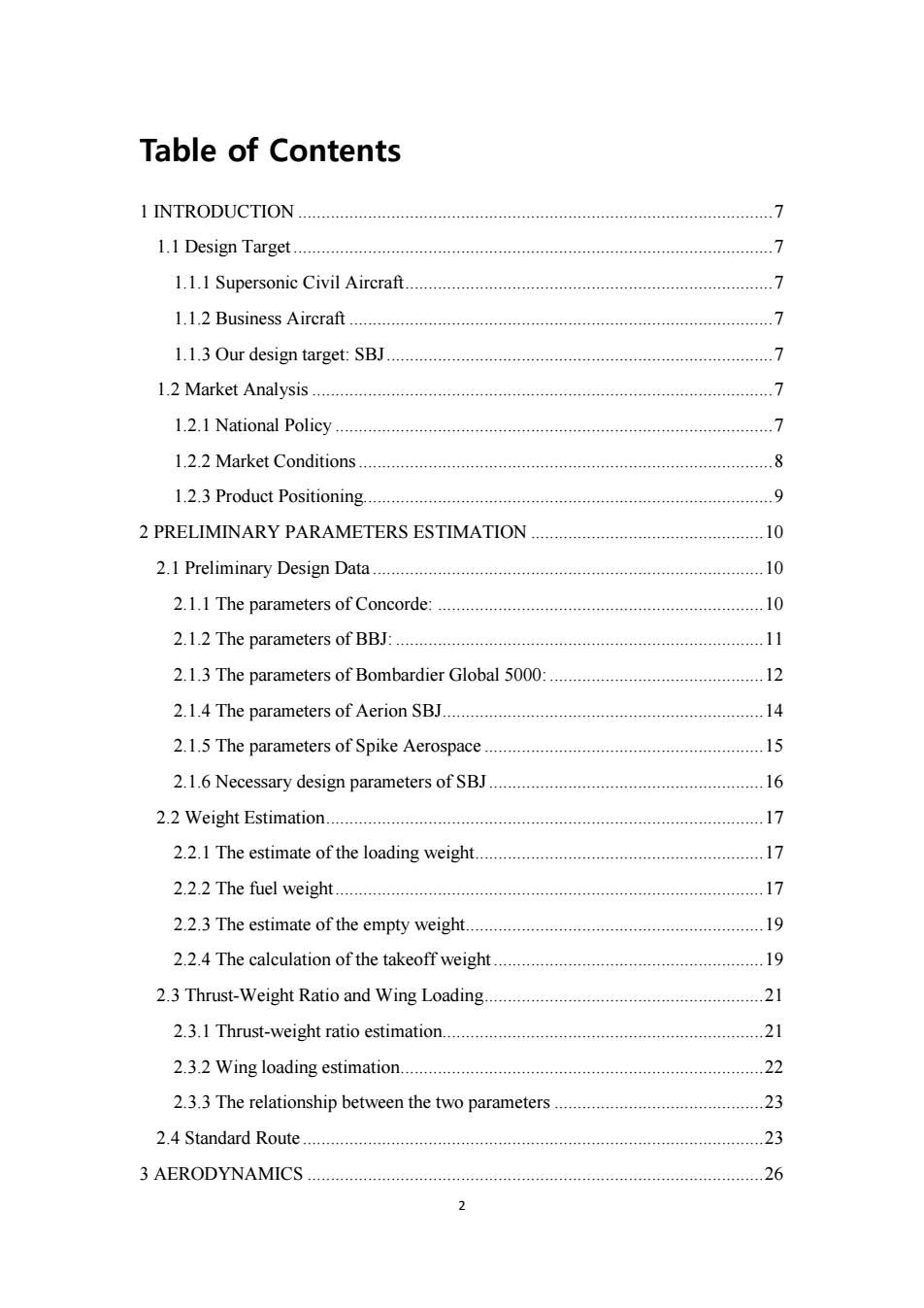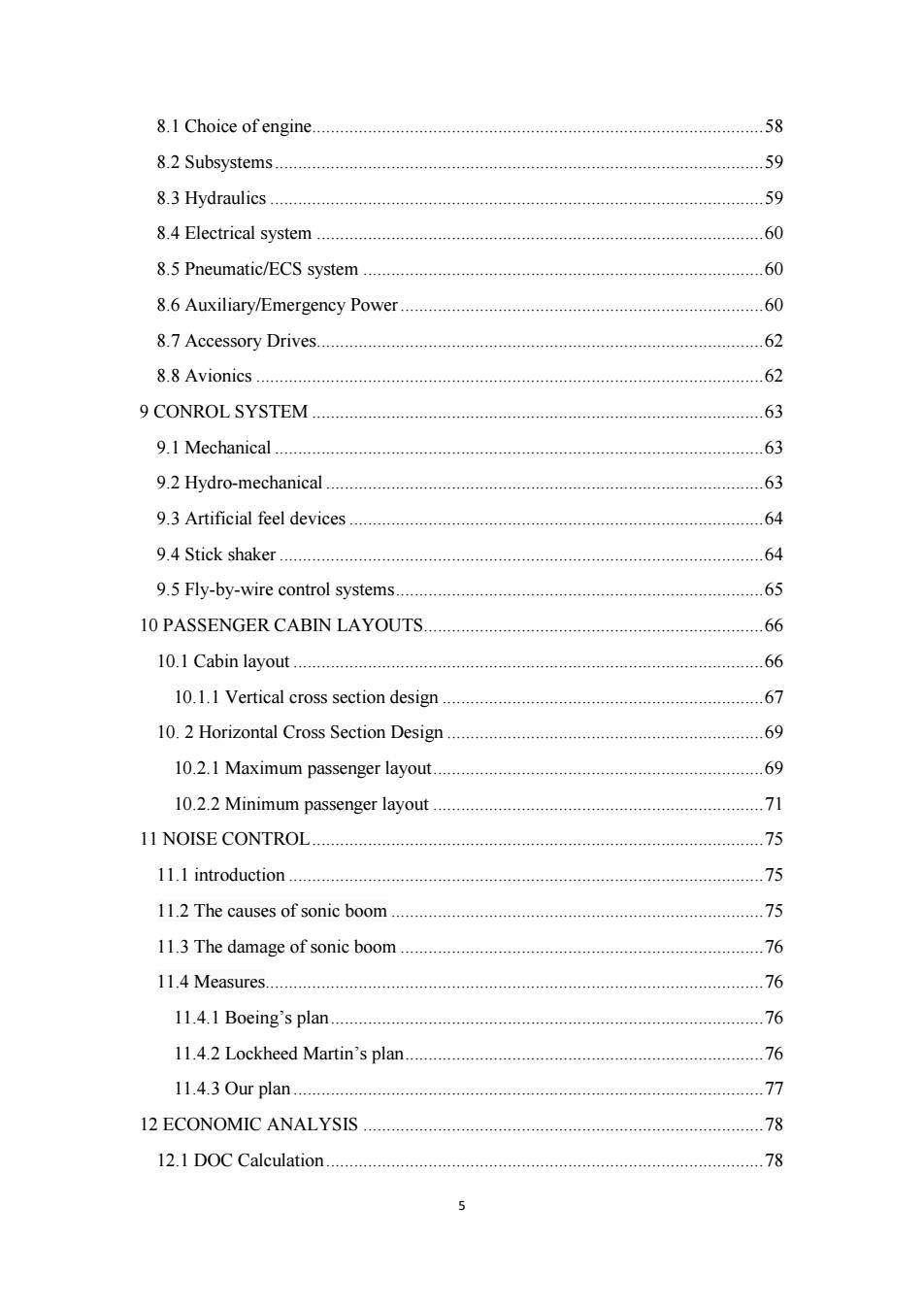
School of Aeronautics&Astronautics Shanghai Jiaotong University SBJ A Supersonic Business Jet In the course Aircraft Design Under the guidance of Dr.Song,Wenbin 李子佳5124139013 姚思远5124139014 温雨鑫5124139015 刘家文5124139018 潘轶韡5124139019 奚鹏浩5124139021
School of Aeronautics& Astronautics Shanghai Jiaotong University SBJ A Supersonic Business Jet In the course Aircraft Design Under the guidance of Dr. Song, Wenbin 李子佳 5124139013 姚思远 5124139014 温雨鑫 5124139015 刘家文 5124139018 潘轶韡 5124139019 奚鹏浩 5124139021

Table of Contents 1 INTRODUCTION........ 7 1.1 Design Target.......... .7 1.1.1 Supersonic Civil Aircraft.. 1.1.2 Business Aircraft......... 7 1.1.3 Our design target:SBJ.... 7 . 1.2 Market Analysis.............. 1.2.1National policy 7 1.2.2 Market Conditions....... 8 1.2.3 Product Positioning.......... .9 2 PRELIMINARY PARAMETERS ESTIMATION 10 2.1 Preliminary Design Data................. 10 2.1.1 The parameters of Concorde:............ 10 2.1.2 The parameters of BBJ: 11 2.1.3 The parameters of Bombardier Global 5000:.... .12 2.1.4 The parameters of Aerion SBJ.............. 14 2.1.5 The parameters of Spike Aerospace... 15 2.1.6 Necessary design parameters of SBJ 16 2.2 Weight Estimation............... 17 2.2.1 The estimate of the loading weight..... .17 2.2.2 The fuel weight... 17 2.2.3 The estimate of the empty weight 19 2.2.4 The calculation of the takeoff weight. 19 2.3 Thrust-Weight Ratio and Wing Loading. 21 2.3.1 Thrust-weight ratio estimation................ .21 2.3.2 Wing loading estimation...... 22 2.3.3 The relationship between the two parameters 23 2.4 Standard Route.... 23 3 AERODYNAMICS............. .26
2 Table of Contents 1 INTRODUCTION ......................................................................................................7 1.1 Design Target .......................................................................................................7 1.1.1 Supersonic Civil Aircraft...............................................................................7 1.1.2 Business Aircraft ...........................................................................................7 1.1.3 Our design target: SBJ...................................................................................7 1.2 Market Analysis ...................................................................................................7 1.2.1 National Policy ..............................................................................................7 1.2.2 Market Conditions.........................................................................................8 1.2.3 Product Positioning........................................................................................9 2 PRELIMINARY PARAMETERS ESTIMATION ..................................................10 2.1 Preliminary Design Data ....................................................................................10 2.1.1 The parameters of Concorde: ......................................................................10 2.1.2 The parameters of BBJ: ...............................................................................11 2.1.3 The parameters of Bombardier Global 5000:..............................................12 2.1.4 The parameters of Aerion SBJ.....................................................................14 2.1.5 The parameters of Spike Aerospace ............................................................15 2.1.6 Necessary design parameters of SBJ...........................................................16 2.2 Weight Estimation..............................................................................................17 2.2.1 The estimate of the loading weight..............................................................17 2.2.2 The fuel weight............................................................................................17 2.2.3 The estimate of the empty weight................................................................19 2.2.4 The calculation of the takeoff weight ..........................................................19 2.3 Thrust-Weight Ratio and Wing Loading............................................................21 2.3.1 Thrust-weight ratio estimation.....................................................................21 2.3.2 Wing loading estimation..............................................................................22 2.3.3 The relationship between the two parameters .............................................23 2.4 Standard Route ...................................................................................................23 3 AERODYNAMICS ..................................................................................................26

3.1 Foreword....... 26 3.1.1 Noise. 26 3.1.2Drag… 26 3.2 Fuselage.… 26 3.3 Nose... 27 3.4Wing.… 28 3.4.1 Wing platform design 28 3.4.2 Airfoil .30 3.5 Tails.. 31 3.5.1 Horizontal tail. 31 3.5.2 Vertical tail. 31 3.6 Engine Position… .. 32 3.7 Area Rule Design.… 32 3.8 Aerodynamics Force Calculation. 34 3.8.1 Low speed characteristics.... 34 3.8.2 High speed characteristics. 37 4 STRUCTURAL DESIGN.................. 40 4.1 Structural Load................ 40 4.1.1 Main load.… 40 4.1.2 Typical flight attitude and loading coefficient 40 4.1.3 Complex loading situation..... 42 4.2 Structural Criteria.... 44 4.2.1 Common Criteria.............. 44 4.2.2 Peculiar Criteria. 45 4.2.3 Environmental Conditions. 45 5 REFINED WEIGHT..... 46 5.1 Fuselage group 46 5.2 Wing group. 46 5.3 Tail Group.… 47 5.4 Power plant....... 47
3 3.1 Foreword ............................................................................................................26 3.1.1 Noise............................................................................................................26 3.1.2 Drag .............................................................................................................26 3.2 Fuselage..............................................................................................................26 3.3 Nose....................................................................................................................27 3.4 Wing...................................................................................................................28 3.4.1 Wing platform design. .................................................................................28 3.4.2 Airfoil ..........................................................................................................30 3.5 Tails....................................................................................................................31 3.5.1 Horizontal tail..............................................................................................31 3.5.2 Vertical tail ..................................................................................................31 3.6 Engine Position ..................................................................................................32 3.7 Area Rule Design ...............................................................................................32 3.8 Aerodynamics Force Calculation.......................................................................34 3.8.1 Low speed characteristics............................................................................34 3.8.2 High speed characteristics. ..........................................................................37 4 STRUCTURAL DESIGN.........................................................................................40 4.1 Structural Load...................................................................................................40 4.1.1 Main load.....................................................................................................40 4.1.2 Typical flight attitude and loading coefficient ............................................40 4.1.3 Complex loading situation...........................................................................42 4.2 Structural Criteria...............................................................................................44 4.2.1 Common Criteria .........................................................................................44 4.2.2 Peculiar Criteria...........................................................................................45 4.2.3 Environmental Conditions...........................................................................45 5 REFINED WEIGHT.................................................................................................46 5.1 Fuselage group ...................................................................................................46 5.2 Wing group.........................................................................................................46 5.3 Tail Group ..........................................................................................................47 5.4 Power plant.........................................................................................................47

5.5 Equipments. 47 5.6 Refined Wo...... 47 6 PERFORMANCE............ 49 6.1 Takeoff performance.... 49 6.1.1 Ground roll distance...... 49 6.1.2 Transition to climb distance.... .50 6.1.3 Climb distance. 50 6.1.4 The total take-off performance................... .50 6.1.5 The takeoff distance with one engine failed......................................... .51 6.2 Steady level flight.. 51 6.2.1 Level cruise.. 51 6.2.2 Maximum level flight speed. 51 6.2.3 Minimum flying speed. 52 6.2.4 Voyage..… 52 6.3 Landing Performance.... 52 6.3.1 Approach Speed. 53 6.3.2 Approach Distance.... .53 6.3.3 Flare Distance......... 53 6.3.4 Ground Roll Distance.. .53 6.3.5 Landing distance........ 53 7LANDING GEAR.............. .54 7.1 Design Requirements......... 54 7.2 Landing Gear Arrangements 55 7.3 Main Design Parameters. 55 7.3.1 Ground angle 55 7.3.2 Landing angle 55 7.3.3 Nose over angle… 56 7.3.4 Wheel base...... 56 7.3.5 Chassis height......... 56 8 POWER PLANT AND FUEL SYSTEMS .58
4 5.5 Equipments.........................................................................................................47 5.6 Refined WOE.......................................................................................................47 6 PERFORMANCE.....................................................................................................49 6.1 Takeoff performance ..........................................................................................49 6.1.1 Ground roll distance ....................................................................................49 6.1.2 Transition to climb distance ........................................................................50 6.1.3 Climb distance .............................................................................................50 6.1.4 The total take-off performance ....................................................................50 6.1.5 The takeoff distance with one engine failed................................................51 6.2 Steady level flight...............................................................................................51 6.2.1 Level cruise..................................................................................................51 6.2.2 Maximum level flight speed ........................................................................51 6.2.3 Minimum flying speed.................................................................................52 6.2.4 Voyage.........................................................................................................52 6.3 Landing Performance .........................................................................................52 6.3.1 Approach Speed...........................................................................................53 6.3.2 Approach Distance ......................................................................................53 6.3.3 Flare Distance ..............................................................................................53 6.3.4 Ground Roll Distance ..................................................................................53 6.3.5 Landing distance..........................................................................................53 7 LANDING GEAR ....................................................................................................54 7.1 Design Requirements .........................................................................................54 7.2 Landing Gear Arrangements..............................................................................55 7.3 Main Design Parameters ....................................................................................55 7.3.1 Ground angle ...............................................................................................55 7.3.2 Landing angle ..............................................................................................55 7.3.3 Nose over angle ...........................................................................................56 7.3.4 Wheel base...................................................................................................56 7.3.5 Chassis height..............................................................................................56 8 POWER PLANT AND FUEL SYSTEMS...............................................................58

8.1 Choice of engine. 58 8.2 Subsystems. 59 8.3 Hydraulics.… 59 8.4 Electrical system 60 8.5 Pneumatic/ECS system 60 8.6 Auxiliary/Emergency Power .60 8.7 Accessory Drives......... 62 8.8 Avionics.… 62 9 CONROL SYSTEM 63 9.1 Mechanical........... 63 9.2 Hydro-mechanical.............. 63 9.3 Artificial feel devices............. 64 9.4 Stick shaker........... 64 9.5 Fly-by-wire control systems. 65 10 PASSENGER CABIN LAYOUTS 66 10.1 Cabin layout............ 66 10.1.1 Vertical cross section design... 67 10.2 Horizontal Cross Section Design.... 69 10.2.1 Maximum passenger layout.... 69 10.2.2 Minimum passenger layout..... 71 11 NOISE CONTROL............... .75 11.1 introduction......... 75 11.2 The causes of sonic boom............ 75 11.3 The damage of sonic boom. 76 11.4 Measures.… 76 11.4.1 Boeing's plan 76 11.4.2 Lockheed Martin's plan 76 11.4.3 Our plan.… 77 12 ECONOMIC ANALYSIS 78 12.1 DOC Calculation... .78
5 8.1 Choice of engine.................................................................................................58 8.2 Subsystems.........................................................................................................59 8.3 Hydraulics ..........................................................................................................59 8.4 Electrical system ................................................................................................60 8.5 Pneumatic/ECS system ......................................................................................60 8.6 Auxiliary/Emergency Power..............................................................................60 8.7 Accessory Drives................................................................................................62 8.8 Avionics .............................................................................................................62 9 CONROL SYSTEM .................................................................................................63 9.1 Mechanical .........................................................................................................63 9.2 Hydro-mechanical ..............................................................................................63 9.3 Artificial feel devices.........................................................................................64 9.4 Stick shaker ........................................................................................................64 9.5 Fly-by-wire control systems...............................................................................65 10 PASSENGER CABIN LAYOUTS.........................................................................66 10.1 Cabin layout .....................................................................................................66 10.1.1 Vertical cross section design .....................................................................67 10. 2 Horizontal Cross Section Design ....................................................................69 10.2.1 Maximum passenger layout.......................................................................69 10.2.2 Minimum passenger layout .......................................................................71 11 NOISE CONTROL.................................................................................................75 11.1 introduction ......................................................................................................75 11.2 The causes of sonic boom ................................................................................75 11.3 The damage of sonic boom ..............................................................................76 11.4 Measures...........................................................................................................76 11.4.1 Boeing’s plan.............................................................................................76 11.4.2 Lockheed Martin’s plan.............................................................................76 11.4.3 Our plan .....................................................................................................77 12 ECONOMIC ANALYSIS ......................................................................................78 12.1 DOC Calculation..............................................................................................78